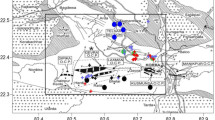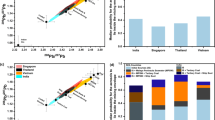Abstract
Lead isotopic ratios (LIR) of eight common food items, street dust, coal, diesel, sediments, lead ore and rainwater from India have been reported for the first time in this paper. This study characterized the source and extent of lead pollution in the different foodstuff consumed in Kolkata, a major metropolis of eastern India. The atmospheric lead input to the food items, sold openly in busy roadside markets of the city, has been quantified. The mean 207/206 and 208/206 LIRs of the eight food items ranged from 0.8847 to 0.8924 and 2.145 to 2.167, respectively. Diesel had the highest mean 207/206 and 208/206 values of 0.9015 and 2.1869, respectively, apart from the lead ore. The food items had a mean lead concentration between 3.78 and 43.35 mg kg−1. The two ratio scatter plots of all the different environmental matrices were spread linearly between the uncontaminated Ichapur sediment and diesel. The 207/206 LIRs of the coal with a mean of 0.8777 did not fall in the linear trend, while the street dust and food samples overlapped strongly. The rainwater sample had a 207/206 LIR of 0.9007. Contaminated sediments in Dhapa, the repository of the city’s municipal garbage, had a mean 207/206 LIR of 0.8658. The corresponding value obtained from the sewage-fed vegetable grown there was 0.8058. The present study indicated that diesel was one of the main contributor to Pb pollution. The atmospheric lead contribution to the food items was in the range of 68.48–86.66 %.








Similar content being viewed by others
References
Azimi S, Ludwig A, The´venot DR, Colin J-L (2003) Trace metal determination in total atmospheric deposition in rural and urban areas. Sci.TotalEnviron 308:247–256
Banerjee D, Kuila P, Ganguly A, Ray L (2010) Market basket survey for chromium, copper, lead and cadmium in some vegetables from different shopping malls in Kolkata, India. EJEAFChe 9(7):1190–1195
Belshaw NS, Freedman PA, O’Nions RK, Frank M, Guo Y (1998) A new variable dispersion double-focusing plasma mass spectrometer with performance illustrated for Pb isotopes. Int. J. Mass Spectrom. 181:51–58
Bhaduri S (2013) Vehicular growth and air quality at major traffic intersection points in Kolkata City: an efficient intervention strategy. The SIJ Transactions on Advances in Space Research & Earth Exploration (ASREE) 1:19–25
Bollhöofer A, Rosman KJR (2001) Isotopic source signatures for atmospheric lead: the Northern Hemisphere. Geochim. Cosmochimica. Acta 65:1727–1740
Brigden K, Labunska I, Santillo D, Allsopp M (2005) Recycling of electronic wastes China and India: Work Place & Environmental Contamination Amsterdam, Greenpeace Research Laboratories, Department of Biological Sciences, University of Exeter, Exeter EX4 4PS, UK, Netherlands, p 1–56
Bureau of Indian Standards (BIS). BIS petrol specifications IS 2796: 2000.
Chang TK, Yao P-H, Shyu G-S, Chang Y-F, Chou Y-C, Shen C-C, Chou C-S (2015) Lead isotope characterization of petroleum fuels in Taipei, Taiwan. Int. J. Environ. Res. Public Health 2015(12):4602–4616. doi:10.3390/ijerph120504602
Chen JM, Tan MG, Li YL, Zhang YM, Lu WW, Tong YP, Zhang GL, Li Y (2005) A lead isotope record of Shanghai atmospheric lead emissions in total suspended particles during the period of phasing out of leaded gasoline. Atmos.Environ. 39:1245–1253
Cheng H, Hu Y (2010) Lead (Pb) isotopic fingerprinting and its applications in lead pollution studies in China: a review. Environ. Pollut. 158:1134–1146
Das A, Bandopadhyay DK, Jee, PK, Karmakar A. (2014). Geochemistry of sediments and water with a health risk assessment of heavy metal contaminated vegetables grown in Dhapa, a waste disposal site in Kolkata, India, World Review of Science, Technology.
Del Rio-Salas R, Ruiz J, De la O-Villanueva M, Valencia-Moreno M, Moreno-Rodríguez V, Gómez-Alvarez A, Meza-Figueroa D (2012) Tracing geogenic and anthropogenic sources in urban dusts: insights from lead isotopes. Atmospheric Environment 60:202–210
Eboh LO, Thomas BE (2005) Analysis of heavy metal content in canabilis leaf and seed cultivated in southern part of Nigeria. Pak. J. Nutr. 4(5):349–351
Evans JA, Pashley V, Richards GJ, Brereton N, Knowles T (2015) Geogenic lead isotope signatures from meat products in Great Britain: potential for use in food authentication and supply chain traceability. Sci. Total Environ. 537:447–452
Feng J, Wang Y, Zhao J, Zhu L, Bian X, Zhang W (2011) Source attributions of heavy metals in rice plant along highway in Eastern China. Journal of Environmental Sciences 23(7):1158–1164
Zhang GL, Yang FG, Zhao WJ, Zhao YG, Yang JL, Gong ZT (2007) Historical change of soil Pb content and Pb isotope signatures of the cultural layers in urban Nanjing. Catena 69:51–56
Gilman AG, Rall TW, Nies AS, Taylor P (eds) (1990) Goodman and Gilman’s the pharmacological basis of therapeutics, 8th edn. New York, Pergamon Press
Grandjean P (2010) Even low-dose lead exposure is hazardous. Lancet. 376:855–856
Harrison RM, Chirgawi MB (1989) The assessment of air and soil as contributors of some metals to vegetable plants. I. Use of a filtered growth cabinet. Sci. Total Environ 83:13–34
Hirata T (1996) Lead isotopic analyses of NIST standard reference materials using multiple collector inductively coupled plasma mass spectrometry coupled with a modified external correction method for mass discrimination effect. Analyst 121:1407–1411
Hu N-j, Huang P , Liu J, Shi X , Ma D , Zhu A , Zhang J , Zhang H , He L (2015) Tracking lead origin in the Yellow River Estuary and nearby Bohai Sea based on its isotopic composition Estuarine, Coastal and Shelf Science 163:99–107
Li H-B, Chen K, Albert L, Juhasz LH, Lena Q M (2015) Environ. Sci. Technol. 49:5080–5087
Jain NB, Hu H (2006) Childhood correlated of blood lead levels in Mumbai and Delhi. Environ Health Perspect. 114:466–470
Jusko TA, Henderson CR Jr, Lanphear BP, Cory-Slechta DA, Parsons PJ, Counter Canfield RL (2008) Blood lead concentrations b10 μg/dL and child intelligence at 6 years of age. Environ Health Perspect. 116:243–248
Komárek M, Ettler V, Chrastný V, Mihaljevič M (2008) Lead isotopes in environmental sciences: a review. Environ Int. 34:562–577
Lanphear BP, Hornung R, Khoury J, Yolton K, Baghurst P, Bellinger DC, et al. (2005) Low-level environmental lead exposure and children's intellectual function: an international pooled analysis. Environ Health Perspect. 113:894–899
Lahd Geagea M, Stille P, Gauthier-Lafaye F, Millet M (2008) Tracing of industrial aerosol sources in an urban environment using Pb, Sr, and Nd isotopes. Environ. SciTechnol. 42(3):692–698
Leung A, Cai ZW, Wong MH (2006) Environmental contamination from electronic waste recycling at Guiyu, southeast China. J Mater Cycles Waste Manag. 8:21–33
Liang F, Zhang GL, Tan MG, Yan CH, Li XL, Li YL, et al. (2010) Lead in children’s blood is mainly caused by coal-fired ash after r phasing out of leaded gasoline in Shanghai. Environ Sci Technol 44:4760–4765
Li F-L, Liu C-Q, Yang YG, Bi XY, Liu TZ, Zhao ZQ (2012) Natural and anthropogenic lead in soils and vegetables around Guiyang city, southwest China: a Pb isotopic approach ‘Sci. Total. Environ. 431:339–347
Liu JX, Wang XY, Zeng J, Chen X (2009) Comparison of lead concentration and isotope ratios in children’s blood and hair. J Hyg Res. 38:375–377
Mihaljevic M, Ettler V, Sebek O, Strnad L, Chrastny V (2006) Pb isotopic signatures of wine and vineyard soils—tracers of Pb origin. J. Geochem. Explor. 88:130–133
Millot R, Allegre C-J, Gaillardet J, Roy S (2004) Lead isotopic systematics of major river sediments: a new estimate of the Pb isotopic composition of the upper continental crust. Chem. Geol. 203(1-2):75–90
Monna F, Hamer K, Lévêque J, Sauer M (2000) Lead isotopes as a reliable marker of early mining and smelting in the Northern Harz province (Lower Saxony,(Germany). Journal of Geochemical Exploration 68:201–210
Mukai H, Furuta N, FUjii T, Ambe Y, Sakamoto K, Hashimoto Y (1993) Characterization of sources of lead in the urban air of Asia using stable lead isotopes. Environ Sci Technol. 27:1347–1358
Ndung'u K, Hibdon S, Véron A, Flegal AR (2011) Pb isotopes reveal different sources of Pb in balsamic and other vinegars. Sci. Total Environ. 409:2754–2760
Oulhote Y, Le Bot B, Poupon J, Lucas JP, Mandin C, Etchevers A, et al. (2011) Identification of sources of lead exposure in French children by lead isotope analysis: a cross sectional study. Environ Health 10:1–11
Rehkämper M, Halliday AN (1998) Accuracy and long term reproducibility of lead isotopic measurements by multiple-collector inductively coupled plasma mass spectrometry using an external method for correction of mass discrimination. Int. J. Mass Spectrom. 181:123–133
Renberg I, Brannvall ML, Bindler R, Emteryd O (2002) Stable lead isotopes and lake sediments—a useful combination for the study of atmospheric lead pollution history. Science of the Total Environment 292:45e54
Safi J, Fischbein A, Haj SE, Sansour R, Jaghabir M, Hashish MA, et al. (2006) Childhood lead exposure in the Palestinian authority, Israel and Jordan, results from the Middle Eastern Regional Cooperation Projects, 1996–2000. Environ HealthPerspect. 114:917–922
SEPA. Environmental quality standards for soils (GB15618-1995); 1995. www.sepa.gov.
Sharma RK, Agrawal M, Marshall FM (2008) Heavy metal (Cu, Zn, Cd and Pb) contamination of vegetables in urban India: a case study in Varanasi. Environmental Pollution 154(2008):254–263
Singh AK, Singh M (2006) Lead decline in the Indian environment resulting from the petrol-lead phase-out programme. Sci. Total Environ. 368(2-3):686–694
Sturges WT, Barrie LA (1987) Lead 206/207 isotope ratios in the atmosphere of north America as tracers of US and Canadian emissions. Nature 329(6135):144–146
Sucharová J, Suchara I, Reimann C, Boyd R, Filzmoser EP (2011) Spatial distribution of lead and lead isotopes in soil B-horizon, forest-floor humus, grass (Avenella flexucosa) and spruce (Picea abies) needles across the Czech Republic. Appl. Geochem. 26:1205–1214
USEPA (2006). Environmental Protective Agency: special report on lead pollution. http://www.epa.gov/air/airtrends/lead.html, 2006.
USEPA, 2010. Risk Based Concentration Table. Available from: http://www.epa.gov/reg3hwmd/risk/human/index.htm.USEPA, 2010. Risk Based Concentration Table. Available from: http://www.epa.gov/reg3hwmd/risk/human/index.htm.
VROM (1994). Intervention values and target values: soil quality standards. The Hague, Netherlands: Netherlands Ministry of Housing, Spatial Planning and Environment, Department of Soil Protection (Ministerie van Volkshuisvesting, Ruimtelijke Ordening en Milieubeheer –VROM); 1994.
Walraven N, vanOs BJH, Klaver GT, Baker JH, Vriend SP (1997) Trace element concentrations and stable lead isotopes in soils as tracers of lead pollution in Graft-DeRijp, the Netherlands. J Geochem Explor 59:47–58
White WM, Albarede Telouk P (2000) High-precision analysis of Pb isotope ratios by multi-collector ICPMS.Chem. Geol. 167:257–270
Yan CH, Xu J, Shen XM (2013) Childhood lead poisoning in China: challenges and opportunities. Environ Health Perspect 121:294–295
Zheng J, Tan M, Shibata Y, Tanaka A, Li Y, Zhang G, Zhang Y, Shan Z (2004) Characteristics of lead isotope ratios and elemental concentrations in PM10 fraction of airborne particulate matter in Shanghai after the phase-out of leaded gasoline. Atmospheric Environment 38(2004):1191–1200
Zhu BQ (1995) The mapping of geochemical provinces in China based on Pb isotopes. Journal of Geochemical Exploration 55:17le181
Zhu BQ, Chen YW, Chang XY (2003) Application of Pb isotopic mapping to environment evaluation in China. Chemical Speciation and Bioavailability 14:49–56
Acknowledgements
This work is the outcome of the research project (RP/CHQMIV/2014/115) funded by the Geological Survey of India, Kolkata in April 2014. The authors would like to thank the Director General of the Geological Survey of India, Kolkata, for his kind permission to publish. Thanks are also due to Mr. Saikat Dutta, Assistant Chemist of the Central Chemical Laboratory, for his help in the sample preparation and digestion.
Author information
Authors and Affiliations
Corresponding author
Additional information
Responsible editor: Philippe Garrigues
Electronic supplementary material
ESM 1
(DOCX 16 kb)
Rights and permissions
About this article
Cite this article
Das, A., Krishna, K., Kumar, R. et al. Tracing lead contamination in foods in the city of Kolkata, India . Environ Sci Pollut Res 23, 22454–22466 (2016). https://doi.org/10.1007/s11356-016-7409-3
Received:
Accepted:
Published:
Issue Date:
DOI: https://doi.org/10.1007/s11356-016-7409-3




